Refine search
No keyword found to refine search
keywords EN
Places
Names
372 documents found
| 1 | 7 |
Documents per page :

Illustration of Ferrari
Nicolas Landemard / Le Pictorium
LePictorium_0308340.jpg
Details of a Ferrari car on display at the Autoworld Museum in Brussels.
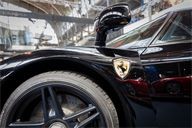
Illustration of Ferrari
Nicolas Landemard / Le Pictorium
LePictorium_0308341.jpg
Details of a Ferrari car on display at the Autoworld Museum in Brussels.
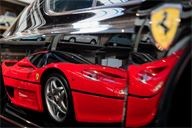
Illustration of Ferrari
Nicolas Landemard / Le Pictorium
LePictorium_0308342.jpg
Details of a Ferrari car on display at the Autoworld Museum in Brussels.
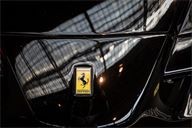
Illustration of Ferrari
Nicolas Landemard / Le Pictorium
LePictorium_0308343.jpg
Details of a Ferrari car on display at the Autoworld Museum in Brussels.
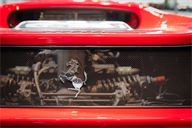
Illustration of Ferrari
Nicolas Landemard / Le Pictorium
LePictorium_0308344.jpg
Details of a Ferrari car on display at the Autoworld Museum in Brussels.
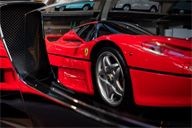
Illustration of Ferrari
Nicolas Landemard / Le Pictorium
LePictorium_0308345.jpg
Details of a Ferrari car on display at the Autoworld Museum in Brussels.
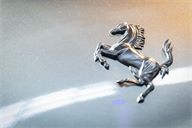
Illustration of Ferrari
Nicolas Landemard / Le Pictorium
LePictorium_0308346.jpg
Details of a Ferrari car on display at the Autoworld Museum in Brussels.
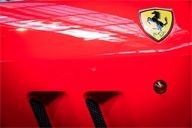
Illustration of Ferrari
Nicolas Landemard / Le Pictorium
LePictorium_0308347.jpg
Details of a Ferrari car on display at the Autoworld Museum in Brussels.

Illustration of Ferrari
Nicolas Landemard / Le Pictorium
LePictorium_0308348.jpg
Details of a Ferrari car on display at the Autoworld Museum in Brussels.
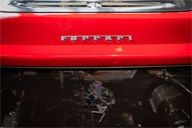
Illustration of Ferrari
Nicolas Landemard / Le Pictorium
LePictorium_0308349.jpg
Details of a Ferrari car on display at the Autoworld Museum in Brussels.
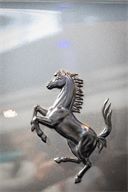
Illustration of Ferrari
Nicolas Landemard / Le Pictorium
LePictorium_0308350.jpg
Details of a Ferrari car on display at the Autoworld Museum in Brussels.
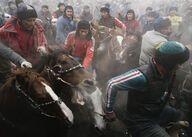
Kokpar in Kazakhstan - An ancient equestrian sport
Gabriel Gauffre / Le Pictorium
LePictorium_0278377.jpg
Kokpar players in the scrum.
Kokpar, a style of horse rugby, where the ball is a weighted goat corpse weighing about 55kg, has been practiced for almost a millennium in Central Asia, and was imported to Kazakhstan from the large intermingling of populations from China and Mongolia.
The goal: to fight for the possession of the ball (the goat), which can only be carried under the rider's leg, stuck against the saddle, and then throw it into a goal, designated on the ground by large circles of white powder. At the beginning of each round, in a fair atmosphere, the commentator announces the prize that will be won by the next scorer - a car, money, cattle, or even a camel.
Kokpar, a style of horse rugby, where the ball is a weighted goat corpse weighing about 55kg, has been practiced for almost a millennium in Central Asia, and was imported to Kazakhstan from the large intermingling of populations from China and Mongolia.
The goal: to fight for the possession of the ball (the goat), which can only be carried under the rider's leg, stuck against the saddle, and then throw it into a goal, designated on the ground by large circles of white powder. At the beginning of each round, in a fair atmosphere, the commentator announces the prize that will be won by the next scorer - a car, money, cattle, or even a camel.
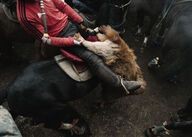
Kokpar in Kazakhstan - An ancient equestrian sport
Gabriel Gauffre / Le Pictorium
LePictorium_0278378.jpg
The goat in possession of a kokpar player.
Kokpar, a style of horse rugby, where the ball is a weighted goat corpse weighing about 55kg, has been practiced for almost a millennium in Central Asia, and was imported to Kazakhstan from the large intermingling of populations from China and Mongolia.
The goal: to fight for the possession of the ball (the goat), which can only be carried under the rider's leg, stuck against the saddle, and then throw it into a goal, designated on the ground by large circles of white powder. At the beginning of each round, in a fair atmosphere, the commentator announces the prize that will be won by the next scorer - a car, money, cattle, or even a camel.
Kokpar, a style of horse rugby, where the ball is a weighted goat corpse weighing about 55kg, has been practiced for almost a millennium in Central Asia, and was imported to Kazakhstan from the large intermingling of populations from China and Mongolia.
The goal: to fight for the possession of the ball (the goat), which can only be carried under the rider's leg, stuck against the saddle, and then throw it into a goal, designated on the ground by large circles of white powder. At the beginning of each round, in a fair atmosphere, the commentator announces the prize that will be won by the next scorer - a car, money, cattle, or even a camel.
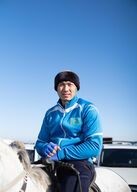
Kokpar in Kazakhstan - An ancient equestrian sport
Gabriel Gauffre / Le Pictorium
LePictorium_0278379.jpg
Kurmanbek Turganbek, 26, is a member of the national kokpar team. He lives only from the income of his sporting activity.
Kokpar, a style of horse rugby, where the ball is a weighted goat corpse weighing about 55kg, has been practiced for almost a millennium in Central Asia, and was imported to Kazakhstan from the large intermingling of populations from China and Mongolia.
The goal: to fight for the possession of the ball (the goat), which can only be carried under the rider's leg, stuck against the saddle, and then throw it into a goal, designated on the ground by large circles of white powder. At the beginning of each round, in a fair atmosphere, the commentator announces the prize that will be won by the next scorer - a car, money, cattle, or even a camel.
Kokpar, a style of horse rugby, where the ball is a weighted goat corpse weighing about 55kg, has been practiced for almost a millennium in Central Asia, and was imported to Kazakhstan from the large intermingling of populations from China and Mongolia.
The goal: to fight for the possession of the ball (the goat), which can only be carried under the rider's leg, stuck against the saddle, and then throw it into a goal, designated on the ground by large circles of white powder. At the beginning of each round, in a fair atmosphere, the commentator announces the prize that will be won by the next scorer - a car, money, cattle, or even a camel.

Kokpar in Kazakhstan - An ancient equestrian sport
Gabriel Gauffre / Le Pictorium
LePictorium_0278380.jpg
A player hoists the goat onto his horse.
Kokpar, a style of horse rugby, where the ball is a weighted goat corpse weighing about 55kg, has been practiced for almost a millennium in Central Asia, and was imported to Kazakhstan from the large intermingling of populations from China and Mongolia.
The goal: to fight for the possession of the ball (the goat), which can only be carried under the rider's leg, stuck against the saddle, and then throw it into a goal, designated on the ground by large circles of white powder. At the beginning of each round, in a fair atmosphere, the commentator announces the prize that will be won by the next scorer - a car, money, cattle, or even a camel.
Kokpar, a style of horse rugby, where the ball is a weighted goat corpse weighing about 55kg, has been practiced for almost a millennium in Central Asia, and was imported to Kazakhstan from the large intermingling of populations from China and Mongolia.
The goal: to fight for the possession of the ball (the goat), which can only be carried under the rider's leg, stuck against the saddle, and then throw it into a goal, designated on the ground by large circles of white powder. At the beginning of each round, in a fair atmosphere, the commentator announces the prize that will be won by the next scorer - a car, money, cattle, or even a camel.

Kokpar in Kazakhstan - An ancient equestrian sport
Gabriel Gauffre / Le Pictorium
LePictorium_0278381.jpg
Kokpar players in the scrum.
Kokpar, a style of horse rugby, where the ball is a weighted goat corpse weighing about 55kg, has been practiced for almost a millennium in Central Asia, and was imported to Kazakhstan from the large intermingling of populations from China and Mongolia.
The goal: to fight for the possession of the ball (the goat), which can only be carried under the rider's leg, stuck against the saddle, and then throw it into a goal, designated on the ground by large circles of white powder. At the beginning of each round, in a fair atmosphere, the commentator announces the prize that will be won by the next scorer - a car, money, cattle, or even a camel.
Kokpar, a style of horse rugby, where the ball is a weighted goat corpse weighing about 55kg, has been practiced for almost a millennium in Central Asia, and was imported to Kazakhstan from the large intermingling of populations from China and Mongolia.
The goal: to fight for the possession of the ball (the goat), which can only be carried under the rider's leg, stuck against the saddle, and then throw it into a goal, designated on the ground by large circles of white powder. At the beginning of each round, in a fair atmosphere, the commentator announces the prize that will be won by the next scorer - a car, money, cattle, or even a camel.

Kokpar in Kazakhstan - An ancient equestrian sport
Gabriel Gauffre / Le Pictorium
LePictorium_0278382.jpg
Kokpar players in the scrum.
Kokpar, a style of horse rugby, where the ball is a weighted goat corpse weighing about 55kg, has been practiced for almost a millennium in Central Asia, and was imported to Kazakhstan from the large intermingling of populations from China and Mongolia.
The goal: to fight for the possession of the ball (the goat), which can only be carried under the rider's leg, stuck against the saddle, and then throw it into a goal, designated on the ground by large circles of white powder. At the beginning of each round, in a fair atmosphere, the commentator announces the prize that will be won by the next scorer - a car, money, cattle, or even a camel.
Kokpar, a style of horse rugby, where the ball is a weighted goat corpse weighing about 55kg, has been practiced for almost a millennium in Central Asia, and was imported to Kazakhstan from the large intermingling of populations from China and Mongolia.
The goal: to fight for the possession of the ball (the goat), which can only be carried under the rider's leg, stuck against the saddle, and then throw it into a goal, designated on the ground by large circles of white powder. At the beginning of each round, in a fair atmosphere, the commentator announces the prize that will be won by the next scorer - a car, money, cattle, or even a camel.
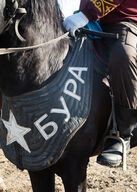
Kokpar in Kazakhstan - An ancient equestrian sport
Gabriel Gauffre / Le Pictorium
LePictorium_0278383.jpg
A crest with the name of a competition horse, "Bura".
Kokpar, a style of horse rugby, where the ball is a weighted goat corpse weighing about 55kg, has been practiced for almost a millennium in Central Asia, and was imported to Kazakhstan from the large intermingling of populations from China and Mongolia.
The goal: to fight for the possession of the ball (the goat), which can only be carried under the rider's leg, stuck against the saddle, and then throw it into a goal, designated on the ground by large circles of white powder. At the beginning of each round, in a fair atmosphere, the commentator announces the prize that will be won by the next scorer - a car, money, cattle, or even a camel.
Kokpar, a style of horse rugby, where the ball is a weighted goat corpse weighing about 55kg, has been practiced for almost a millennium in Central Asia, and was imported to Kazakhstan from the large intermingling of populations from China and Mongolia.
The goal: to fight for the possession of the ball (the goat), which can only be carried under the rider's leg, stuck against the saddle, and then throw it into a goal, designated on the ground by large circles of white powder. At the beginning of each round, in a fair atmosphere, the commentator announces the prize that will be won by the next scorer - a car, money, cattle, or even a camel.
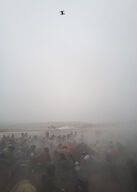
Kokpar in Kazakhstan - An ancient equestrian sport
Gabriel Gauffre / Le Pictorium
LePictorium_0278384.jpg
During the most complicated scrimmages, a drone helps with the refereeing.
Kokpar, a style of horse rugby, where the ball is a weighted goat corpse weighing about 55kg, has been practiced for almost a millennium in Central Asia, and was imported to Kazakhstan from the large intermingling of populations from China and Mongolia.
The goal: to fight for the possession of the ball (the goat), which can only be carried under the rider's leg, stuck against the saddle, and then throw it into a goal, designated on the ground by large circles of white powder. At the beginning of each round, in a fair atmosphere, the commentator announces the prize that will be won by the next scorer - a car, money, cattle, or even a camel.
Kokpar, a style of horse rugby, where the ball is a weighted goat corpse weighing about 55kg, has been practiced for almost a millennium in Central Asia, and was imported to Kazakhstan from the large intermingling of populations from China and Mongolia.
The goal: to fight for the possession of the ball (the goat), which can only be carried under the rider's leg, stuck against the saddle, and then throw it into a goal, designated on the ground by large circles of white powder. At the beginning of each round, in a fair atmosphere, the commentator announces the prize that will be won by the next scorer - a car, money, cattle, or even a camel.
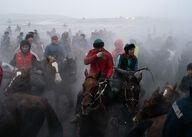
Kokpar in Kazakhstan - An ancient equestrian sport
Gabriel Gauffre / Le Pictorium
LePictorium_0278385.jpg
Kokpar players in the scrum.
Kokpar, a style of horse rugby, where the ball is a weighted goat corpse weighing about 55kg, has been practiced for almost a millennium in Central Asia, and was imported to Kazakhstan from the large intermingling of populations from China and Mongolia.
The goal: to fight for the possession of the ball (the goat), which can only be carried under the rider's leg, stuck against the saddle, and then throw it into a goal, designated on the ground by large circles of white powder. At the beginning of each round, in a fair atmosphere, the commentator announces the prize that will be won by the next scorer - a car, money, cattle, or even a camel.
Kokpar, a style of horse rugby, where the ball is a weighted goat corpse weighing about 55kg, has been practiced for almost a millennium in Central Asia, and was imported to Kazakhstan from the large intermingling of populations from China and Mongolia.
The goal: to fight for the possession of the ball (the goat), which can only be carried under the rider's leg, stuck against the saddle, and then throw it into a goal, designated on the ground by large circles of white powder. At the beginning of each round, in a fair atmosphere, the commentator announces the prize that will be won by the next scorer - a car, money, cattle, or even a camel.
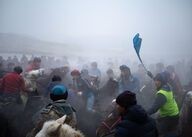
Kokpar in Kazakhstan - An ancient equestrian sport
Gabriel Gauffre / Le Pictorium
LePictorium_0278386.jpg
A referee raises his flag to signal a foul during a scrum.
Kokpar, a style of horse rugby, where the ball is a weighted goat corpse weighing about 55kg, has been practiced for almost a millennium in Central Asia, and was imported to Kazakhstan from the large intermingling of populations from China and Mongolia.
The goal: to fight for the possession of the ball (the goat), which can only be carried under the rider's leg, stuck against the saddle, and then throw it into a goal, designated on the ground by large circles of white powder. At the beginning of each round, in a fair atmosphere, the commentator announces the prize that will be won by the next scorer - a car, money, cattle, or even a camel.
Kokpar, a style of horse rugby, where the ball is a weighted goat corpse weighing about 55kg, has been practiced for almost a millennium in Central Asia, and was imported to Kazakhstan from the large intermingling of populations from China and Mongolia.
The goal: to fight for the possession of the ball (the goat), which can only be carried under the rider's leg, stuck against the saddle, and then throw it into a goal, designated on the ground by large circles of white powder. At the beginning of each round, in a fair atmosphere, the commentator announces the prize that will be won by the next scorer - a car, money, cattle, or even a camel.
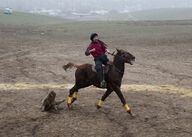
Kokpar in Kazakhstan - An ancient equestrian sport
Gabriel Gauffre / Le Pictorium
LePictorium_0278387.jpg
A player releases the goat into the goal.
Kokpar, a style of horse rugby, where the ball is a weighted goat corpse weighing about 55kg, has been practiced for almost a millennium in Central Asia, and was imported to Kazakhstan from the large intermingling of populations from China and Mongolia.
The goal: to fight for the possession of the ball (the goat), which can only be carried under the rider's leg, stuck against the saddle, and then throw it into a goal, designated on the ground by large circles of white powder. At the beginning of each round, in a fair atmosphere, the commentator announces the prize that will be won by the next scorer - a car, money, cattle, or even a camel.
Kokpar, a style of horse rugby, where the ball is a weighted goat corpse weighing about 55kg, has been practiced for almost a millennium in Central Asia, and was imported to Kazakhstan from the large intermingling of populations from China and Mongolia.
The goal: to fight for the possession of the ball (the goat), which can only be carried under the rider's leg, stuck against the saddle, and then throw it into a goal, designated on the ground by large circles of white powder. At the beginning of each round, in a fair atmosphere, the commentator announces the prize that will be won by the next scorer - a car, money, cattle, or even a camel.
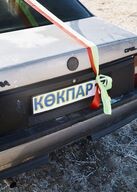
Kokpar in Kazakhstan - An ancient equestrian sport
Gabriel Gauffre / Le Pictorium
LePictorium_0278388.jpg
One of the prizes for the winners, a used Opel Vectra.
Kokpar, a style of horse rugby, where the ball is a weighted goat corpse weighing about 55kg, has been practiced for almost a millennium in Central Asia, and was imported to Kazakhstan from the large intermingling of populations from China and Mongolia.
The goal: to fight for the possession of the ball (the goat), which can only be carried under the rider's leg, stuck against the saddle, and then throw it into a goal, designated on the ground by large circles of white powder. At the beginning of each round, in a fair atmosphere, the commentator announces the prize that will be won by the next scorer - a car, money, cattle, or even a camel.
Kokpar, a style of horse rugby, where the ball is a weighted goat corpse weighing about 55kg, has been practiced for almost a millennium in Central Asia, and was imported to Kazakhstan from the large intermingling of populations from China and Mongolia.
The goal: to fight for the possession of the ball (the goat), which can only be carried under the rider's leg, stuck against the saddle, and then throw it into a goal, designated on the ground by large circles of white powder. At the beginning of each round, in a fair atmosphere, the commentator announces the prize that will be won by the next scorer - a car, money, cattle, or even a camel.
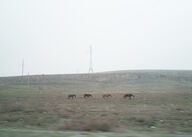
Kokpar in Kazakhstan - An ancient equestrian sport
Gabriel Gauffre / Le Pictorium
LePictorium_0278389.jpg
Wild horses on the road.
Kokpar, a style of horse rugby, where the ball is a weighted goat corpse weighing about 55kg, has been practiced for almost a millennium in Central Asia, and was imported to Kazakhstan from the large intermingling of populations from China and Mongolia.
The goal: to fight for the possession of the ball (the goat), which can only be carried under the rider's leg, stuck against the saddle, and then throw it into a goal, designated on the ground by large circles of white powder. At the beginning of each round, in a fair atmosphere, the commentator announces the prize that will be won by the next scorer - a car, money, cattle, or even a camel.
Kokpar, a style of horse rugby, where the ball is a weighted goat corpse weighing about 55kg, has been practiced for almost a millennium in Central Asia, and was imported to Kazakhstan from the large intermingling of populations from China and Mongolia.
The goal: to fight for the possession of the ball (the goat), which can only be carried under the rider's leg, stuck against the saddle, and then throw it into a goal, designated on the ground by large circles of white powder. At the beginning of each round, in a fair atmosphere, the commentator announces the prize that will be won by the next scorer - a car, money, cattle, or even a camel.
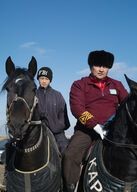
Kokpar in Kazakhstan - An ancient equestrian sport
Gabriel Gauffre / Le Pictorium
LePictorium_0278390.jpg
Two kokpar players. Some start early, from 13 years old.
Kokpar, a style of horse rugby, where the ball is a weighted goat corpse weighing about 55kg, has been practiced for almost a millennium in Central Asia, and was imported to Kazakhstan from the large intermingling of populations from China and Mongolia.
The goal: to fight for the possession of the ball (the goat), which can only be carried under the rider's leg, stuck against the saddle, and then throw it into a goal, designated on the ground by large circles of white powder. At the beginning of each round, in a fair atmosphere, the commentator announces the prize that will be won by the next scorer - a car, money, cattle, or even a camel.
Kokpar, a style of horse rugby, where the ball is a weighted goat corpse weighing about 55kg, has been practiced for almost a millennium in Central Asia, and was imported to Kazakhstan from the large intermingling of populations from China and Mongolia.
The goal: to fight for the possession of the ball (the goat), which can only be carried under the rider's leg, stuck against the saddle, and then throw it into a goal, designated on the ground by large circles of white powder. At the beginning of each round, in a fair atmosphere, the commentator announces the prize that will be won by the next scorer - a car, money, cattle, or even a camel.

Kokpar in Kazakhstan - An ancient equestrian sport
Gabriel Gauffre / Le Pictorium
LePictorium_0278391.jpg
The winner of a round of kokpar.
Kokpar, a style of horse rugby, where the ball is a weighted goat corpse weighing about 55kg, has been practiced for almost a millennium in Central Asia, and was imported to Kazakhstan from the large intermingling of populations from China and Mongolia.
The goal: to fight for the possession of the ball (the goat), which can only be carried under the rider's leg, stuck against the saddle, and then throw it into a goal, designated on the ground by large circles of white powder. At the beginning of each round, in a fair atmosphere, the commentator announces the prize that will be won by the next scorer - a car, money, cattle, or even a camel.
Kokpar, a style of horse rugby, where the ball is a weighted goat corpse weighing about 55kg, has been practiced for almost a millennium in Central Asia, and was imported to Kazakhstan from the large intermingling of populations from China and Mongolia.
The goal: to fight for the possession of the ball (the goat), which can only be carried under the rider's leg, stuck against the saddle, and then throw it into a goal, designated on the ground by large circles of white powder. At the beginning of each round, in a fair atmosphere, the commentator announces the prize that will be won by the next scorer - a car, money, cattle, or even a camel.
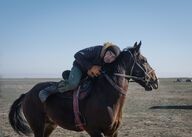
Kokpar in Kazakhstan - An ancient equestrian sport
Gabriel Gauffre / Le Pictorium
LePictorium_0278392.jpg
A kokpar player with his horse.
Kokpar, a style of horse rugby, where the ball is a weighted goat corpse weighing about 55kg, has been practiced for almost a millennium in Central Asia, and was imported to Kazakhstan from the large intermingling of populations from China and Mongolia.
The goal: to fight for the possession of the ball (the goat), which can only be carried under the rider's leg, stuck against the saddle, and then throw it into a goal, designated on the ground by large circles of white powder. At the beginning of each round, in a fair atmosphere, the commentator announces the prize that will be won by the next scorer - a car, money, cattle, or even a camel.
Kokpar, a style of horse rugby, where the ball is a weighted goat corpse weighing about 55kg, has been practiced for almost a millennium in Central Asia, and was imported to Kazakhstan from the large intermingling of populations from China and Mongolia.
The goal: to fight for the possession of the ball (the goat), which can only be carried under the rider's leg, stuck against the saddle, and then throw it into a goal, designated on the ground by large circles of white powder. At the beginning of each round, in a fair atmosphere, the commentator announces the prize that will be won by the next scorer - a car, money, cattle, or even a camel.
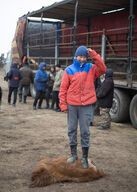
Kokpar in Kazakhstan - An ancient equestrian sport
Gabriel Gauffre / Le Pictorium
LePictorium_0278393.jpg
A child stands on the goat that will be used as a ball during a kokpar competition.
Kokpar, a style of horse rugby, where the ball is a weighted goat corpse weighing about 55kg, has been practiced for almost a millennium in Central Asia, and was imported to Kazakhstan from the large intermingling of populations from China and Mongolia.
The goal: to fight for the possession of the ball (the goat), which can only be carried under the rider's leg, stuck against the saddle, and then throw it into a goal, designated on the ground by large circles of white powder. At the beginning of each round, in a fair atmosphere, the commentator announces the prize that will be won by the next scorer - a car, money, cattle, or even a camel.
Kokpar, a style of horse rugby, where the ball is a weighted goat corpse weighing about 55kg, has been practiced for almost a millennium in Central Asia, and was imported to Kazakhstan from the large intermingling of populations from China and Mongolia.
The goal: to fight for the possession of the ball (the goat), which can only be carried under the rider's leg, stuck against the saddle, and then throw it into a goal, designated on the ground by large circles of white powder. At the beginning of each round, in a fair atmosphere, the commentator announces the prize that will be won by the next scorer - a car, money, cattle, or even a camel.
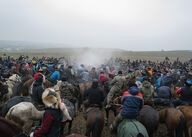
Kokpar in Kazakhstan - An ancient equestrian sport
Gabriel Gauffre / Le Pictorium
LePictorium_0278394.jpg
Kokpar players in the scrum.
Kokpar, a style of horse rugby, where the ball is a weighted goat corpse weighing about 55kg, has been practiced for almost a millennium in Central Asia, and was imported to Kazakhstan from the large intermingling of populations from China and Mongolia.
The goal: to fight for the possession of the ball (the goat), which can only be carried under the rider's leg, stuck against the saddle, and then throw it into a goal, designated on the ground by large circles of white powder. At the beginning of each round, in a fair atmosphere, the commentator announces the prize that will be won by the next scorer - a car, money, cattle, or even a camel.
Kokpar, a style of horse rugby, where the ball is a weighted goat corpse weighing about 55kg, has been practiced for almost a millennium in Central Asia, and was imported to Kazakhstan from the large intermingling of populations from China and Mongolia.
The goal: to fight for the possession of the ball (the goat), which can only be carried under the rider's leg, stuck against the saddle, and then throw it into a goal, designated on the ground by large circles of white powder. At the beginning of each round, in a fair atmosphere, the commentator announces the prize that will be won by the next scorer - a car, money, cattle, or even a camel.
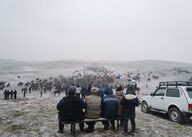
Kokpar in Kazakhstan - An ancient equestrian sport
Gabriel Gauffre / Le Pictorium
LePictorium_0278395.jpg
Spectators watch a kokpar match.
Kokpar, a style of horse rugby, where the ball is a weighted goat corpse weighing about 55kg, has been practiced for almost a millennium in Central Asia, and was imported to Kazakhstan from the large intermingling of populations from China and Mongolia.
The goal: to fight for the possession of the ball (the goat), which can only be carried under the rider's leg, stuck against the saddle, and then throw it into a goal, designated on the ground by large circles of white powder. At the beginning of each round, in a fair atmosphere, the commentator announces the prize that will be won by the next scorer - a car, money, cattle, or even a camel.
Kokpar, a style of horse rugby, where the ball is a weighted goat corpse weighing about 55kg, has been practiced for almost a millennium in Central Asia, and was imported to Kazakhstan from the large intermingling of populations from China and Mongolia.
The goal: to fight for the possession of the ball (the goat), which can only be carried under the rider's leg, stuck against the saddle, and then throw it into a goal, designated on the ground by large circles of white powder. At the beginning of each round, in a fair atmosphere, the commentator announces the prize that will be won by the next scorer - a car, money, cattle, or even a camel.
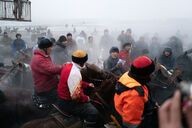
Kokpar in Kazakhstan - An ancient equestrian sport
Gabriel Gauffre / Le Pictorium
LePictorium_0278396.jpg
The winner of a round observes his prize.
Kokpar, a style of horse rugby, where the ball is a weighted goat corpse weighing about 55kg, has been practiced for almost a millennium in Central Asia, and was imported to Kazakhstan from the large intermingling of populations from China and Mongolia.
The goal: to fight for the possession of the ball (the goat), which can only be carried under the rider's leg, stuck against the saddle, and then throw it into a goal, designated on the ground by large circles of white powder. At the beginning of each round, in a fair atmosphere, the commentator announces the prize that will be won by the next scorer - a car, money, cattle, or even a camel.
Kokpar, a style of horse rugby, where the ball is a weighted goat corpse weighing about 55kg, has been practiced for almost a millennium in Central Asia, and was imported to Kazakhstan from the large intermingling of populations from China and Mongolia.
The goal: to fight for the possession of the ball (the goat), which can only be carried under the rider's leg, stuck against the saddle, and then throw it into a goal, designated on the ground by large circles of white powder. At the beginning of each round, in a fair atmosphere, the commentator announces the prize that will be won by the next scorer - a car, money, cattle, or even a camel.
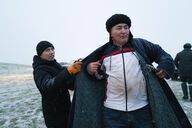
Kokpar in Kazakhstan - An ancient equestrian sport
Gabriel Gauffre / Le Pictorium
LePictorium_0278397.jpg
A kokpar player is about to leave at the end of a game.
Kokpar, a style of horse rugby, where the ball is a weighted goat corpse weighing about 55kg, has been practiced for almost a millennium in Central Asia, and was imported to Kazakhstan from the large intermingling of populations from China and Mongolia.
The goal: to fight for the possession of the ball (the goat), which can only be carried under the rider's leg, stuck against the saddle, and then throw it into a goal, designated on the ground by large circles of white powder. At the beginning of each round, in a fair atmosphere, the commentator announces the prize that will be won by the next scorer - a car, money, cattle, or even a camel.
Kokpar, a style of horse rugby, where the ball is a weighted goat corpse weighing about 55kg, has been practiced for almost a millennium in Central Asia, and was imported to Kazakhstan from the large intermingling of populations from China and Mongolia.
The goal: to fight for the possession of the ball (the goat), which can only be carried under the rider's leg, stuck against the saddle, and then throw it into a goal, designated on the ground by large circles of white powder. At the beginning of each round, in a fair atmosphere, the commentator announces the prize that will be won by the next scorer - a car, money, cattle, or even a camel.
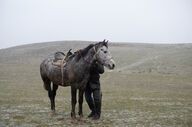
Kokpar in Kazakhstan - An ancient equestrian sport
Gabriel Gauffre / Le Pictorium
LePictorium_0278398.jpg
A kokpar player with his horse.
Kokpar, a style of horse rugby, where the ball is a weighted goat corpse weighing about 55kg, has been practiced for almost a millennium in Central Asia, and was imported to Kazakhstan from the large intermingling of populations from China and Mongolia.
The goal: to fight for the possession of the ball (the goat), which can only be carried under the rider's leg, stuck against the saddle, and then throw it into a goal, designated on the ground by large circles of white powder. At the beginning of each round, in a fair atmosphere, the commentator announces the prize that will be won by the next scorer - a car, money, cattle, or even a camel.
Kokpar, a style of horse rugby, where the ball is a weighted goat corpse weighing about 55kg, has been practiced for almost a millennium in Central Asia, and was imported to Kazakhstan from the large intermingling of populations from China and Mongolia.
The goal: to fight for the possession of the ball (the goat), which can only be carried under the rider's leg, stuck against the saddle, and then throw it into a goal, designated on the ground by large circles of white powder. At the beginning of each round, in a fair atmosphere, the commentator announces the prize that will be won by the next scorer - a car, money, cattle, or even a camel.

Kokpar in Kazakhstan - An ancient equestrian sport
Gabriel Gauffre / Le Pictorium
LePictorium_0278399.jpg
A kokpar player leaves with his prize.
Kokpar, a style of horse rugby, where the ball is a weighted goat corpse weighing about 55kg, has been practiced for almost a millennium in Central Asia, and was imported to Kazakhstan from the large intermingling of populations from China and Mongolia.
The goal: to fight for the possession of the ball (the goat), which can only be carried under the rider's leg, stuck against the saddle, and then throw it into a goal, designated on the ground by large circles of white powder. At the beginning of each round, in a fair atmosphere, the commentator announces the prize that will be won by the next scorer - a car, money, cattle, or even a camel.
Kokpar, a style of horse rugby, where the ball is a weighted goat corpse weighing about 55kg, has been practiced for almost a millennium in Central Asia, and was imported to Kazakhstan from the large intermingling of populations from China and Mongolia.
The goal: to fight for the possession of the ball (the goat), which can only be carried under the rider's leg, stuck against the saddle, and then throw it into a goal, designated on the ground by large circles of white powder. At the beginning of each round, in a fair atmosphere, the commentator announces the prize that will be won by the next scorer - a car, money, cattle, or even a camel.

Kokpar in Kazakhstan - An ancient equestrian sport
Gabriel Gauffre / Le Pictorium
LePictorium_0278400.jpg
Kokpar players between two games.
Kokpar, a style of horse rugby, where the ball is a weighted goat corpse weighing about 55kg, has been practiced for almost a millennium in Central Asia, and was imported to Kazakhstan from the large intermingling of populations from China and Mongolia.
The goal: to fight for the possession of the ball (the goat), which can only be carried under the rider's leg, stuck against the saddle, and then throw it into a goal, designated on the ground by large circles of white powder. At the beginning of each round, in a fair atmosphere, the commentator announces the prize that will be won by the next scorer - a car, money, cattle, or even a camel.
Kokpar, a style of horse rugby, where the ball is a weighted goat corpse weighing about 55kg, has been practiced for almost a millennium in Central Asia, and was imported to Kazakhstan from the large intermingling of populations from China and Mongolia.
The goal: to fight for the possession of the ball (the goat), which can only be carried under the rider's leg, stuck against the saddle, and then throw it into a goal, designated on the ground by large circles of white powder. At the beginning of each round, in a fair atmosphere, the commentator announces the prize that will be won by the next scorer - a car, money, cattle, or even a camel.
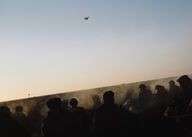
Kokpar in Kazakhstan - An ancient equestrian sport
Gabriel Gauffre / Le Pictorium
LePictorium_0278401.jpg
Kokpar players in the scrum.
Kokpar, a style of horse rugby, where the ball is a weighted goat corpse weighing about 55kg, has been practiced for almost a millennium in Central Asia, and was imported to Kazakhstan from the large intermingling of populations from China and Mongolia.
The goal: to fight for the possession of the ball (the goat), which can only be carried under the rider's leg, stuck against the saddle, and then throw it into a goal, designated on the ground by large circles of white powder. At the beginning of each round, in a fair atmosphere, the commentator announces the prize that will be won by the next scorer - a car, money, cattle, or even a camel.
Kokpar, a style of horse rugby, where the ball is a weighted goat corpse weighing about 55kg, has been practiced for almost a millennium in Central Asia, and was imported to Kazakhstan from the large intermingling of populations from China and Mongolia.
The goal: to fight for the possession of the ball (the goat), which can only be carried under the rider's leg, stuck against the saddle, and then throw it into a goal, designated on the ground by large circles of white powder. At the beginning of each round, in a fair atmosphere, the commentator announces the prize that will be won by the next scorer - a car, money, cattle, or even a camel.
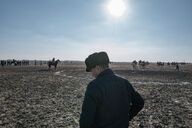
Kokpar in Kazakhstan - An ancient equestrian sport
Gabriel Gauffre / Le Pictorium
LePictorium_0278402.jpg
A spectator watches a kokpar match.
Kokpar, a style of horse rugby, where the ball is a weighted goat corpse weighing about 55kg, has been practiced for almost a millennium in Central Asia, and was imported to Kazakhstan from the large intermingling of populations from China and Mongolia.
The goal: to fight for the possession of the ball (the goat), which can only be carried under the rider's leg, stuck against the saddle, and then throw it into a goal, designated on the ground by large circles of white powder. At the beginning of each round, in a fair atmosphere, the commentator announces the prize that will be won by the next scorer - a car, money, cattle, or even a camel.
Kokpar, a style of horse rugby, where the ball is a weighted goat corpse weighing about 55kg, has been practiced for almost a millennium in Central Asia, and was imported to Kazakhstan from the large intermingling of populations from China and Mongolia.
The goal: to fight for the possession of the ball (the goat), which can only be carried under the rider's leg, stuck against the saddle, and then throw it into a goal, designated on the ground by large circles of white powder. At the beginning of each round, in a fair atmosphere, the commentator announces the prize that will be won by the next scorer - a car, money, cattle, or even a camel.
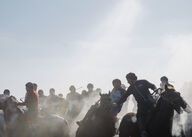
Kokpar in Kazakhstan - An ancient equestrian sport
Gabriel Gauffre / Le Pictorium
LePictorium_0278403.jpg
Kokpar players in the scrum.
Kokpar, a style of horse rugby, where the ball is a weighted goat corpse weighing about 55kg, has been practiced for almost a millennium in Central Asia, and was imported to Kazakhstan from the large intermingling of populations from China and Mongolia.
The goal: to fight for the possession of the ball (the goat), which can only be carried under the rider's leg, stuck against the saddle, and then throw it into a goal, designated on the ground by large circles of white powder. At the beginning of each round, in a fair atmosphere, the commentator announces the prize that will be won by the next scorer - a car, money, cattle, or even a camel.
Kokpar, a style of horse rugby, where the ball is a weighted goat corpse weighing about 55kg, has been practiced for almost a millennium in Central Asia, and was imported to Kazakhstan from the large intermingling of populations from China and Mongolia.
The goal: to fight for the possession of the ball (the goat), which can only be carried under the rider's leg, stuck against the saddle, and then throw it into a goal, designated on the ground by large circles of white powder. At the beginning of each round, in a fair atmosphere, the commentator announces the prize that will be won by the next scorer - a car, money, cattle, or even a camel.
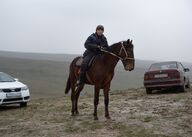
Kokpar in Kazakhstan - An ancient equestrian sport
Gabriel Gauffre / Le Pictorium
LePictorium_0278404.jpg
A kokpar player with his horse.
Kokpar, a style of horse rugby, where the ball is a weighted goat corpse weighing about 55kg, has been practiced for almost a millennium in Central Asia, and was imported to Kazakhstan from the large intermingling of populations from China and Mongolia.
The goal: to fight for the possession of the ball (the goat), which can only be carried under the rider's leg, stuck against the saddle, and then throw it into a goal, designated on the ground by large circles of white powder. At the beginning of each round, in a fair atmosphere, the commentator announces the prize that will be won by the next scorer - a car, money, cattle, or even a camel.
Kokpar, a style of horse rugby, where the ball is a weighted goat corpse weighing about 55kg, has been practiced for almost a millennium in Central Asia, and was imported to Kazakhstan from the large intermingling of populations from China and Mongolia.
The goal: to fight for the possession of the ball (the goat), which can only be carried under the rider's leg, stuck against the saddle, and then throw it into a goal, designated on the ground by large circles of white powder. At the beginning of each round, in a fair atmosphere, the commentator announces the prize that will be won by the next scorer - a car, money, cattle, or even a camel.
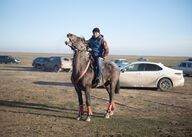
Kokpar in Kazakhstan - An ancient equestrian sport
Gabriel Gauffre / Le Pictorium
LePictorium_0278405.jpg
A kokpar player with his horse.
Kokpar, a style of horse rugby, where the ball is a weighted goat corpse weighing about 55kg, has been practiced for almost a millennium in Central Asia, and was imported to Kazakhstan from the large intermingling of populations from China and Mongolia.
The goal: to fight for the possession of the ball (the goat), which can only be carried under the rider's leg, stuck against the saddle, and then throw it into a goal, designated on the ground by large circles of white powder. At the beginning of each round, in a fair atmosphere, the commentator announces the prize that will be won by the next scorer - a car, money, cattle, or even a camel.
Kokpar, a style of horse rugby, where the ball is a weighted goat corpse weighing about 55kg, has been practiced for almost a millennium in Central Asia, and was imported to Kazakhstan from the large intermingling of populations from China and Mongolia.
The goal: to fight for the possession of the ball (the goat), which can only be carried under the rider's leg, stuck against the saddle, and then throw it into a goal, designated on the ground by large circles of white powder. At the beginning of each round, in a fair atmosphere, the commentator announces the prize that will be won by the next scorer - a car, money, cattle, or even a camel.
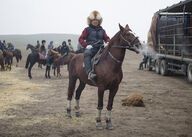
Kokpar in Kazakhstan - An ancient equestrian sport
Gabriel Gauffre / Le Pictorium
LePictorium_0278406.jpg
A kokpar player with his horse.
Kokpar, a style of horse rugby, where the ball is a weighted goat corpse weighing about 55kg, has been practiced for almost a millennium in Central Asia, and was imported to Kazakhstan from the large intermingling of populations from China and Mongolia.
The goal: to fight for the possession of the ball (the goat), which can only be carried under the rider's leg, stuck against the saddle, and then throw it into a goal, designated on the ground by large circles of white powder. At the beginning of each round, in a fair atmosphere, the commentator announces the prize that will be won by the next scorer - a car, money, cattle, or even a camel.
Kokpar, a style of horse rugby, where the ball is a weighted goat corpse weighing about 55kg, has been practiced for almost a millennium in Central Asia, and was imported to Kazakhstan from the large intermingling of populations from China and Mongolia.
The goal: to fight for the possession of the ball (the goat), which can only be carried under the rider's leg, stuck against the saddle, and then throw it into a goal, designated on the ground by large circles of white powder. At the beginning of each round, in a fair atmosphere, the commentator announces the prize that will be won by the next scorer - a car, money, cattle, or even a camel.

Kokpar in Kazakhstan - An ancient equestrian sport
Gabriel Gauffre / Le Pictorium
LePictorium_0278407.jpg
A kokpar player with his horse.
Kokpar, a style of horse rugby, where the ball is a weighted goat corpse weighing about 55kg, has been practiced for almost a millennium in Central Asia, and was imported to Kazakhstan from the large intermingling of populations from China and Mongolia.
The goal: to fight for the possession of the ball (the goat), which can only be carried under the rider's leg, stuck against the saddle, and then throw it into a goal, designated on the ground by large circles of white powder. At the beginning of each round, in a fair atmosphere, the commentator announces the prize that will be won by the next scorer - a car, money, cattle, or even a camel.
Kokpar, a style of horse rugby, where the ball is a weighted goat corpse weighing about 55kg, has been practiced for almost a millennium in Central Asia, and was imported to Kazakhstan from the large intermingling of populations from China and Mongolia.
The goal: to fight for the possession of the ball (the goat), which can only be carried under the rider's leg, stuck against the saddle, and then throw it into a goal, designated on the ground by large circles of white powder. At the beginning of each round, in a fair atmosphere, the commentator announces the prize that will be won by the next scorer - a car, money, cattle, or even a camel.
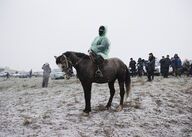
Kokpar in Kazakhstan - An ancient equestrian sport
Gabriel Gauffre / Le Pictorium
LePictorium_0278408.jpg
A kokpar player with his horse.
Kokpar, a style of horse rugby, where the ball is a weighted goat corpse weighing about 55kg, has been practiced for almost a millennium in Central Asia, and was imported to Kazakhstan from the large intermingling of populations from China and Mongolia.
The goal: to fight for the possession of the ball (the goat), which can only be carried under the rider's leg, stuck against the saddle, and then throw it into a goal, designated on the ground by large circles of white powder. At the beginning of each round, in a fair atmosphere, the commentator announces the prize that will be won by the next scorer - a car, money, cattle, or even a camel.
Kokpar, a style of horse rugby, where the ball is a weighted goat corpse weighing about 55kg, has been practiced for almost a millennium in Central Asia, and was imported to Kazakhstan from the large intermingling of populations from China and Mongolia.
The goal: to fight for the possession of the ball (the goat), which can only be carried under the rider's leg, stuck against the saddle, and then throw it into a goal, designated on the ground by large circles of white powder. At the beginning of each round, in a fair atmosphere, the commentator announces the prize that will be won by the next scorer - a car, money, cattle, or even a camel.
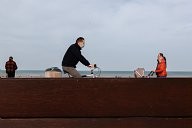
Illustrations of La Panne (Belgium) during the Covid period.
Nicolas Landemard / Le Pictorium
LePictorium_0242232.jpg
While the first weekend of sunshine and good weather settles in after several days of negative temperatures in the country, and the measures of containment and fight against covid are still effective, tourists flock to the small seaside town on the border with France. Holidaymakers go to the beach and pass an empty café that is closed because of COVID.
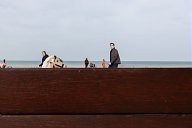
Illustrations of La Panne (Belgium) during the Covid period.
Nicolas Landemard / Le Pictorium
LePictorium_0242233.jpg
While the first weekend of sunshine and good weather settles in after several days of negative temperatures in the country, and the measures of containment and fight against covid are still effective, tourists flock to the small seaside town on the border with France. Holidaymakers go to the beach and pass an empty café that is closed because of COVID.

Anti-COVID rally in Brussels
Nicolas Landemard / Le Pictorium
LePictorium_0240958.jpg
A few hundred demonstrators gathered today in the Belgian capital to protest against the measures taken in the fight against the coronavirus pandemic. The police forces were in large numbers (several hundred riot police according to some sources) and announced almost 500 arrests (in different points of the city).

Anti-COVID rally in Brussels
Nicolas Landemard / Le Pictorium
LePictorium_0240959.jpg
A few hundred demonstrators gathered today in the Belgian capital to protest against the measures taken in the fight against the coronavirus pandemic. The police forces were in large numbers (several hundred riot police according to some sources) and announced almost 500 arrests (in different points of the city).

Anti-COVID rally in Brussels
Nicolas Landemard / Le Pictorium
LePictorium_0240960.jpg
A few hundred demonstrators gathered today in the Belgian capital to protest against the measures taken in the fight against the coronavirus pandemic. The police forces were in large numbers (several hundred riot police according to some sources) and announced almost 500 arrests (in different points of the city).

Anti-COVID rally in Brussels
Nicolas Landemard / Le Pictorium
LePictorium_0240961.jpg
A few hundred demonstrators gathered today in the Belgian capital to protest against the measures taken in the fight against the coronavirus pandemic. The police forces were in large numbers (several hundred riot police according to some sources) and announced almost 500 arrests (in different points of the city).

Anti-COVID rally in Brussels
Nicolas Landemard / Le Pictorium
LePictorium_0240962.jpg
A few hundred demonstrators gathered today in the Belgian capital to protest against the measures taken in the fight against the coronavirus pandemic. The police forces were in large numbers (several hundred riot police according to some sources) and announced almost 500 arrests (in different points of the city).

Anti-COVID rally in Brussels
Nicolas Landemard / Le Pictorium
LePictorium_0240963.jpg
A few hundred demonstrators gathered today in the Belgian capital to protest against the measures taken in the fight against the coronavirus pandemic. The police forces were in large numbers (several hundred riot police according to some sources) and announced almost 500 arrests (in different points of the city).

Anti-COVID rally in Brussels
Nicolas Landemard / Le Pictorium
LePictorium_0240964.jpg
A few hundred demonstrators gathered today in the Belgian capital to protest against the measures taken in the fight against the coronavirus pandemic. The police forces were in large numbers (several hundred riot police according to some sources) and announced almost 500 arrests (in different points of the city).

Anti-COVID rally in Brussels
Nicolas Landemard / Le Pictorium
LePictorium_0240965.jpg
A few hundred demonstrators gathered today in the Belgian capital to protest against the measures taken in the fight against the coronavirus pandemic. The police forces were in large numbers (several hundred riot police according to some sources) and announced almost 500 arrests (in different points of the city).

Anti-COVID rally in Brussels
Nicolas Landemard / Le Pictorium
LePictorium_0240966.jpg
A few hundred demonstrators gathered today in the Belgian capital to protest against the measures taken in the fight against the coronavirus pandemic. The police forces were in large numbers (several hundred riot police according to some sources) and announced almost 500 arrests (in different points of the city).

Anti-COVID rally in Brussels
Nicolas Landemard / Le Pictorium
LePictorium_0240967.jpg
A few hundred demonstrators gathered today in the Belgian capital to protest against the measures taken in the fight against the coronavirus pandemic. The police forces were in large numbers (several hundred riot police according to some sources) and announced almost 500 arrests (in different points of the city).

Anti-COVID rally in Brussels
Nicolas Landemard / Le Pictorium
LePictorium_0240968.jpg
A few hundred demonstrators gathered today in the Belgian capital to protest against the measures taken in the fight against the coronavirus pandemic. The police forces were in large numbers (several hundred riot police according to some sources) and announced almost 500 arrests (in different points of the city).

Anti-COVID rally in Brussels
Nicolas Landemard / Le Pictorium
LePictorium_0240969.jpg
A few hundred demonstrators gathered today in the Belgian capital to protest against the measures taken in the fight against the coronavirus pandemic. The police forces were in large numbers (several hundred riot police according to some sources) and announced almost 500 arrests (in different points of the city).

Anti-COVID rally in Brussels
Nicolas Landemard / Le Pictorium
LePictorium_0240970.jpg
A few hundred demonstrators gathered today in the Belgian capital to protest against the measures taken in the fight against the coronavirus pandemic. The police forces were in large numbers (several hundred riot police according to some sources) and announced almost 500 arrests (in different points of the city).

Anti-COVID rally in Brussels
Nicolas Landemard / Le Pictorium
LePictorium_0240971.jpg
A few hundred demonstrators gathered today in the Belgian capital to protest against the measures taken in the fight against the coronavirus pandemic. The police forces were in large numbers (several hundred riot police according to some sources) and announced almost 500 arrests (in different points of the city).

Anti-COVID rally in Brussels
Nicolas Landemard / Le Pictorium
LePictorium_0240972.jpg
A few hundred demonstrators gathered today in the Belgian capital to protest against the measures taken in the fight against the coronavirus pandemic. The police forces were in large numbers (several hundred riot police according to some sources) and announced almost 500 arrests (in different points of the city).
Next page
